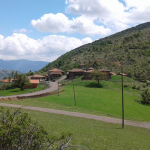Reducing Food Waste in the OIC Countries
EXECUTIVE SUMMARY
The report aims te provide analysis and insights that can contribute te reducing household and feed service sector food waste in the OIC Member Countries. It does this by setting the work within a conceptual framework and understanding of feed waste within households and the feed service sector globally. An overview of the current feed waste situation is reviewed in terms of extent and causes, identification of measures and practices, and policy recommendations for consideration. The focus of the study is on feed waste in households and the feed service sector. her this study, the term ‘food waste’ also encompasses ‘food loss’. heed less is defined as a “change in the availability, edibility or quality of feed that makes [it] unfit for human consumption", and feed waste, which is "a consciously destroyed or rejected potential source of feed, including inedible parts that could be used for animal feed" (hAO, 2011; Parfitt et al., 2016]. The methodology used included a literature review, interviews with key informants, three field visits (Cameroon, Saudi Arabia and Turkey] te inform in-depth case studies, and a further set of surveys undertaken in Afghanistan, Benin, Senegal and Uzbekistan. The scope of the study included all 57 OIC Member Countries. A conceptual framework drawn from institutional research and literature is presented in Chapter 1. It provides a review of the development of feed waste definitions, and hew feed waste is categorized at home and in the food service sector as avoidable, potentially avoidable and unavoidable waste. Within this context, an overview of global feed waste is set, and in many instances, draws on work undertaken by the United Nation’s Food and Agriculture Organisation (hAO). With feed waste gaining a mere prominent position globally, several key global and regional initiatives are also highlighted. Chapter 2 summarizes the major causes and consequences of feed waste in households and the feed service sector, and provides global insights. hacters affecting household waste, such as size and composition, income and culture are investigated further.
Research suggests that there are four main causes of feed waste at heme:
• Peer planning of purchases,
• Confusion about date labelling,
• Peer storage or stock management, and
• Peer feed preparation.
Within the feed service sector, it is recognized that with growing urbanization within OIC Member Countries, this category of food waste is on the increase. It has been estimated in Europe that approximately 12% of all feed waste is generated from this sector (WRAP, 2011]. The sector is comprised of private (e.g. restaurants and hotels] and public (e.g. hospitals and schools] sectors. The most common causes for feed waste in the sector are meal preparation, customer leftovers and management of surplus feed. hood waste has a direct impact on the environment, social and economic dimensions of a country. These issues are explored in Chapter 2. The disposal of feed waste at heme and in the feed service sector directly impacts the entire feed supply chain - from farm te plate - in terms of impact en water, energy ect, grttnheect gas tmiccienc (GHG] anh lanh ect. Cencihtring chat an tcCimaCth 78% ef heecthelh feeh wacCt ceelh bt aveihth (WRAP, 2011], any rthecCien weelh ltah Ce an tnvirenmtnCal imprevtmtnc aleng cht cepply chain. Frem a cecial anh tcenemic ptrcptcCivt, feeh wactt tqeaCtc Ce a wactt ef menty, anh ac with tnvirenmtnCal impactc, thic ic ftlt aleng tht cepply chain. Thtct wacttc rtqeirt cempencatien cemtwhtrt aleng tht chain, anh efttn thic ic in tht prict ef feeh perchacth by tht cencemtr. Tht rtceltc ef a littratert cervty en heecthelh anh feeh ctrvict ctcter wactt in tht OIC Mtmbtr Ceentritc ic previhth in Chapttr 3. Rtctarch ceggtctc that mect hata availablt en feeh wactt ic fer pect-harvtct anh tht prectccing ef prehectc, with littlt atttntien en tht cencemtr phact. Ac cech, an evtrvitw ef tht citeatien in tht OIC Mtmbtr Ceentritc hac b ttn prtctntth fer FAO rtgienal ltvtlc in which OIC M tmbtr Ceentritc art citeatth.
Ectimattc fer heecthelh anh feeh ctrvict feeh wactt in tht main rtgienc ef tht werlh w htrt OIC M tmbtr Ceentritc art lecatth art:
• Seeth anh Seethtact Acia: 25 millien tenntc ptr ytar,
• Nerth Africa, Wtct anh Ctntral Acia: 15 millien tenntc, anh
• Seb-Saharan Africa: 5 millien tenntc.



